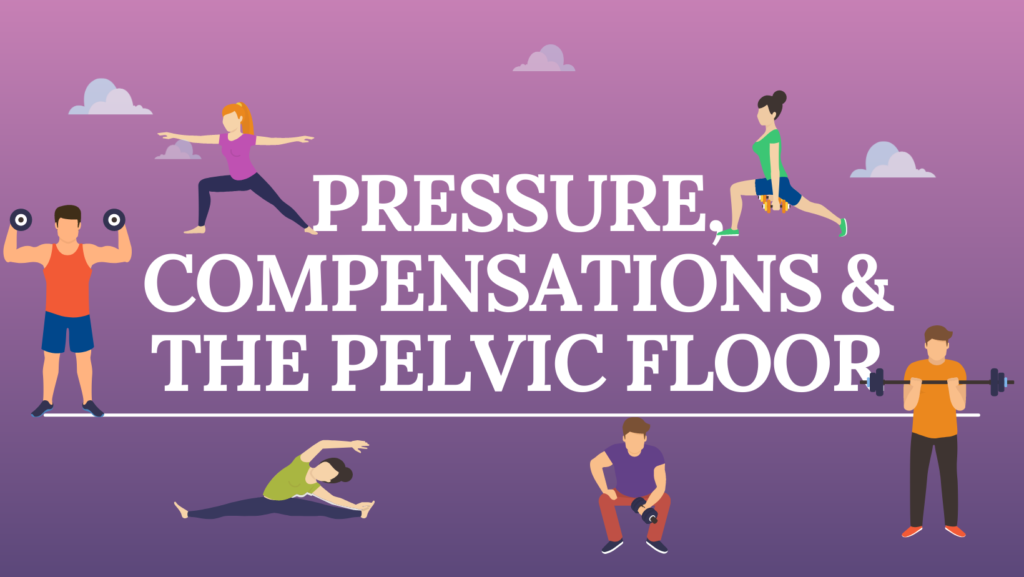
| Pressure, Compensations and the Pelvic Floor |
| As a Pilates instructor that specializes in sports injuries, I spend a lot of time explaining why we’re strengthening the obliques when the shoulder hurts. Or why we’re focused on balance when there’s back pain. Working with the pelvic floor and deep core with the “Restore Your Core” (RYC) work has brought this up even more. Why are we working thoracic extension for hypertonic pelvic floor? What does hip mobility and posture even have to do with core strength and pelvic floor dysfunction? Whether it’s the good old “Abs of Steel” concept, the new juicy booty butt-lift programs, or gym equipment that promises to target one area, as a culture, we’ve been conditioned that we can spot check our problem areas. This is true to some extent with Physical Therapy, where we really need to focus and rehab one area of the body. However, it’s most definitely a lot more complicated when it comes to moving away from PT and incorporating fully functional movement back into our bodies. Most of my clients very quickly understand that their knees don’t operate in a vacuum. Knee pain or knee dysfunction frequently requires us to work on a whole slew of areas: balance, ankle mobility, ankle stability, proprioception, quads, muscle memory, hamstrings, hip stabilizers, hip mobility, core strength, posture…the whole gauntlet. In that same vein, the pelvic floor and abdominal muscles also do not operate in a vacuum. Treating them as if they function alone by spot checking or focusing strictly on problem areas can very frequently lead to more problems. The muscles can become too strong, we can develop a hypervigilance around the area, or we can train even more dysfunction into the target area and make things worse. From my experience, the holistic full body approach is the power behind why Pilates, Stretch Therapy and now RYC, work so well. When we look at our body, we intuitively know that our systems work together. But for some reason, when we move to exercise, we lose that approach to connection. Pilates, Stretch Therapy and RYC help build that connection back into the body, in a particularly hard to reach area…the pelvic floor and deep core. So why do we focus on the thoracic spine when dealing with pelvic floor dysfunction? Why bother with breathing and balance? What about all of that hip and posture work? The two simplest answers are 1) pressure and 2) compensations. When we are extremely tight and restricted in our movement, whether it’s a tight thoracic spine, limited spinal rotation, a locked up ribcage or tight hips, we create a system in which our body cannot move freely. That tightness and restriction means that we are 1) having to move through compensation patterns to get to where we’re going with our bodies, and 2) we are moving in a way that causes additional pressure on our core and pelvic floor. Compensations may lead to improper movement and recruitment patterns, weakness, tightness, pain and dysfunction. Additional pressure on the pelvic floor and core can lead to things like the inability to engage the abdominal muscles, stress incontinence, prolapse, unhealing or worsening diastasis recti…and more compensation patterns, improper muscle engagements, weakness, tightness, pain and dysfunction. Being able to blend the RYC tools into both my personal and professional Pilates and Stretch practice has opened up a new level of body awareness and understanding for both myself and my clients. Incorporating the concept of pressure reduction to movement has created an entirely new map for how I approach sports injuries. While social media thrives on the big, flashy, sexy movements, the real changes my clients are experiencing are coming from the deeper, slower, more consistent work that focuses on functionality and intention. The nervous system thrives on slower, intentional movement. When we slow down and focus, we can actually do the deeper healing work, the reprogramming of movement patterns, the upgrading in neural connections and the fine tuning of our body systems. We can change our posture, change our breathing, and change our pain patterns. We can also reprogram our brain to move our bodies more efficiently. Efficient movement = better strength, faster speed and higher endurance. Taking the RYC course has been extremely validating in how I have been working with clients for the last 13 years and is really a testament to the power behind a functional + holistic approach to movement. As a super active mama, who had no guidance post child birth and ran a half marathon at 6 months postpartum, I’m particularly excited to incorporate more post natal recovery work into my offerings. If you’re interested in learning more about how I’m using RYC with Pilates and Stretch Therapy, shoot me a line or hop on in for a session. -Rubecca |
